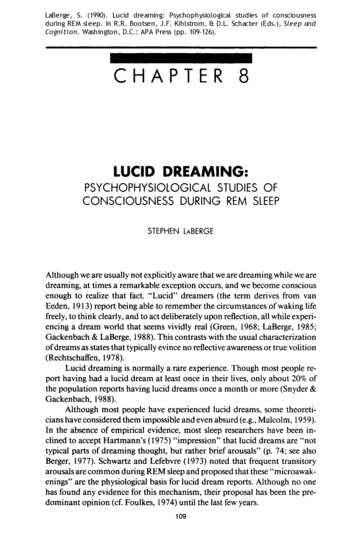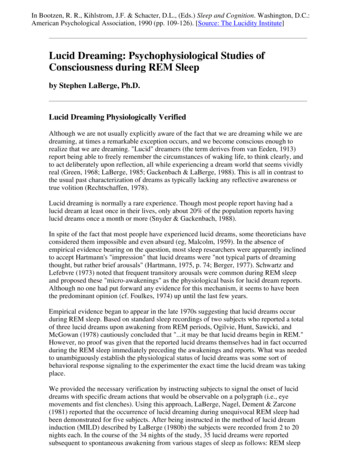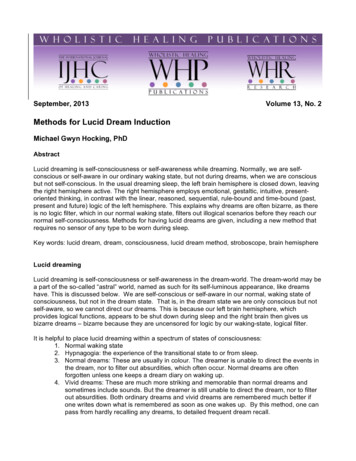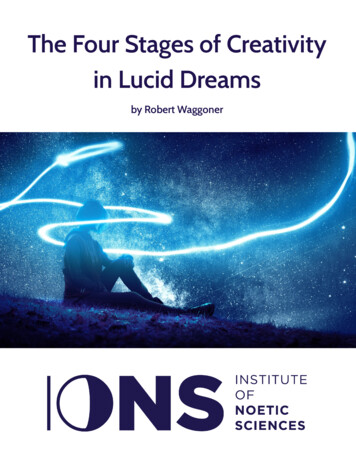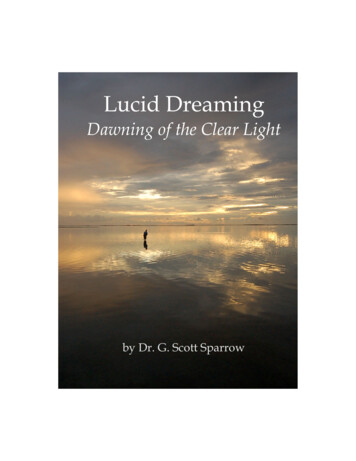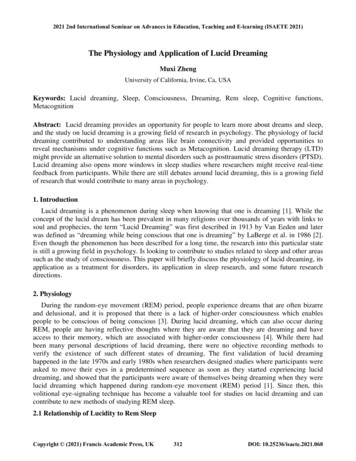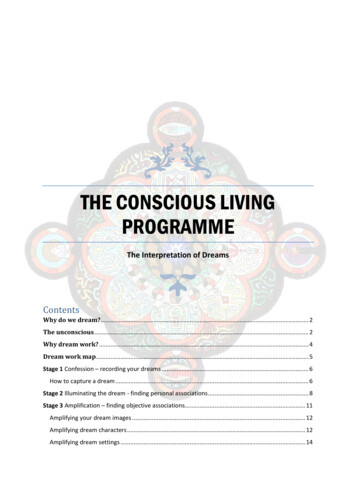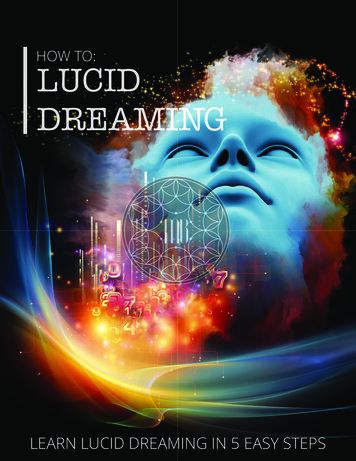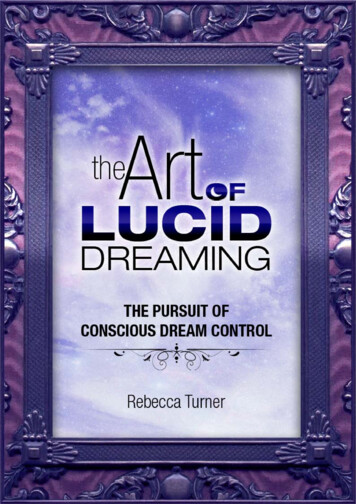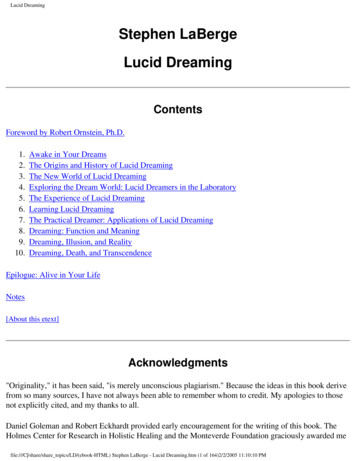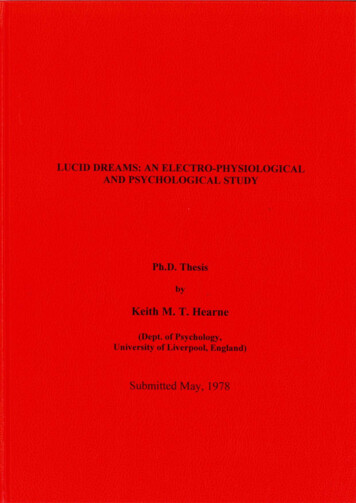
Transcription
LUCID DREAMS:AN ELECTRO-PHYSIOLOGICAL ANDPSYCHOLOGICAL STUDYTHESISSUBMITTED IN ACCORDANCE WITH THE REQUIREMENTS OFTHE UNIVERSITY OF LIVERPOOLFOR THE DEGREE OFDOCTOR IN PHILOSOPHYbyKEITH MELVYN TREVOR HEARNE BSc MScMAY 1978
Dr Heame's original chart-record of the first ocular signalsfrom a lucid-dream, and his 'dream-machine' invention arenow on permanent display in the Science Museum, London.*****Dr Keith Heame conducted the world's first sleep-lab researchinto 'lucid' (conscious, controllable) dreams for his PhD atLiverpool University, England.Heame: obtained the first eye-movement signals from a subjectwithin the lucid dream state, in April 1975 discovered the 'pre-Iucid' REM burst, and 'lightswitch effect' in dreams discovered the basic physiological parameters of luciddreaming invented the world's ftrst 'dream machine'
Background to the first PhD in the world on Lucid Dreaming and theoriginal discovery of the ocular-signaling technique from lucid dreamsAfter obtaining a BSc in psychology from Reading University, England, in 1973,Keith Hearne went to Hull University in the Autumn of that year, intending to conductresearch for a PhD on hypnotic dreams, following discoveries he had made in 'hypnooneirography'. He decided instead to use newly acquired computer equipment to researchelectro-physiological aspects of visual imagery*.During that time he became skilled in running a sleep laboratory. He became interestedin 'lucid' dreaming (the paradoxical conscious awareness of dreaming within the dreamitself) and reasoned that it must be possible for a lucid dreamer to communicate to theworld of wakefulness. A problem, though, was the inherent muscular paralysis of REMsleep.In 1975 it suddenly occurred to Hearne that since the eye musculature is not inhibitedin REM sleep, it might be possible to get subjects to signal by making deliberate ocularmovements.On the morning of 5th April 1975, Hearne wired up a lucid dream subject who wasinstructed to make a sequence of left-right eye-movements on becoming lucid. A luciddream was reported at about 8 am, but unfortunately, the monitoring equipment had justbeen switched off. A week later, on the morning of 12th April 1975, the same subject hadanother lucid dream. The first signals in the world from a lucid dream were thus recorded.Hearne continued to obtain more records over the next months. He wound up the workon visual imagery, submitting it for an MSc* and moved to Liverpool University, where hewas offered a sleep-laboratory, to research lucid dreams for this PhD, using paid subjects.During the course of this work he discovered the basic electro-physiological features oflucid dreams, including the pre-Iucid REM burst. Hearne also discovered the 'light switch'phenomenon, and invented the first ' dream machine'.In 1975 Hearne informed psychology departments at American universities of hisfindings including Stanford (W. Dement) and Chicago (A. Rechtschaffen).(See on, letter from Rechtschaffen to Hearne)*Hearne, Keith M.T. (1975) Visually evoked responses and visual imagery. MSc thesis.University of Hull, England.N .B. A book written by Dr Hearne fully described his research into lucid dreams: Hearne,K. ( 1990) The dream machine. Aq uaria n Press, Welli ngboro ugh, England .(This book may be downloaded at www.keithhearne.com)Other books :Heat'ne, K. (1989) Visions of the future. Aquarian Press, Wellingborough, England.Melbourne, D. & Hearne, K. (1997) Dream interpretation - the secret. Blandford Press,London.Melbourne, D. & Hearne, K. (2002) The Dream Oracle. Foulsham, England,Melbourne, D. & Hearne, K. (1999) The Meaning of Your Dreams. Blandford PressHearne, K. & Melbourne, D. (2001) Understanding dreams. New Holland Press.(Several other books are pending publication).
1 )! 1- A I{ 1 ,',' ! I\: 1 t q'I (,I1, ',II"\1,1 J it', C 11 1 \ 1 1 "'f V I , 1LKeith "l . 1. lie:! " .])cp.:tCloenl of Psyc l o l. 0AYT h lhll '; rsH"f !lulL111111 HUb 7!l : . t:;!I'CI.,\ .lDUCiI r Hr , HcnHlI' :Tlmn;5 much for your Yccen t !ettt: on yeu,.- )"c Id dre.1m )" ,'! arch.cert3inly (ht"k t h i s research Jt; iml'("- [II1t beC:lURe i is th 011C occ;wi"""'i1r.ll t Ie dn:!llroer c,:m 0::l:iric'11 1y c "':Jiullte his dJ:CDCI consciovtmC!:;s ",IdleIt is in pr-or,rct;u,YI " h,n' c a dded the ingcl1i ,,:; iod i lli l' l rtlm t c l. entof ha\' i ng lh(' d!'t:!:l, C I' co:m:1Unic;lI: c h il bs r"3r i o n ,- to Y IJ "t t llC amt:liml' . TllInis, of cours-' , 1;{1 1 r e.!l ;wn to use e ye m \' .,,",,' t; (or till scommunicat.ion Sill t(' "JjJ kno\.· tl:e e}'. us cl . sI:L}rtJli nly n e t i n h 'hit'dQUJ:in g RE ,! s le e p \"he 'ell!'! otheJ: 1!lusc l c tl' oup ; '1l'e- - .1t l eas t tholie (n till'1"'lId al1d fle ck l'egion.r h;we 1:110 simi l a r l uck "' ith "ye lr.(lvement: p. :l5.a mode of CD Ul1 J c.1J:ion duriu!; st '!"i' h' r he;;t lldyo fa n:lr cn j"l'rLc- ' Id)',;,!r-i ,1i . l eep p llr, J ys i s , Site oulo H' sj)onf! to my question s . ·h i 1" tll leep par, lysi.5 ,.-Lth "lcaF "'Y" movements :in the rcqu" ,;«,;j ,Hr "l ion,As yo',,' kntl ' '; I 11 dn? or : le p paralysis cl ' ; ;1 llE': v,1rinnt I n "'hid,\o'.!lk ln g e ,; JIl:;elo u t: nfl r,u S;: not yeL co plct("') )' rlir.:lnl"h cL( Tn,, ' i! "' hythe hn);,l i ,Of, le h31111,instions ,.h id: ,,"u;111)' .'l{'.-{)t:Jpany sleep p;:ndy"I",HVict,'ld il S bllll" ) ll}ltion s r a th e r than dn'a ' , LIl , . L'llxe is"mix. "r,-' )f l'e . J ity pCl'c pUon a nd ,-lreil- ' ')E,)c l Ofl d is " " i 11 :!;[YII I j" ,\.It''which :1how both t h:1,spol1t:iln i ous.onc " C00 .100 " eye 'Clove (! II. dct"logattack D s l eep p3ro l ysfH ,I IlJll conv in ced by ],0",1' evidence cha L l u cSd cl n amp. do i ndeed oc c urd uring jH-: 1 pln- t ods ,I "'Q ul d a l so Rt!(!RS . in tu it iv ly. l l".i Ill," /l,),wl occur d u in g l\Rrt'l s lne!'. However , the f.:11 " I' f,C) cO llnjc . Ce .-ithy move;Jl('l1U; , l ()e, not neecs sa 11)' l:e.l11 thnt ueid dn'aTIls cl" "ni: o C ! Uli:l ;RE f s l eep .Th t: 1)d ht be Sl "slu}; i bh ne 1I 0 ey e ''''cmt'n l l!nl'Jt: rolin :;RE 1 sleep ,,·hl 'l, ,",ould pr v1l111, r, il' c unic 1 [ i"" by t:. at: :: chni 'l"'"Do nO" 'R'm- ' about n y " p r adini' ),our find(n s around .,,'(wk ,3il1ce:rcly youtH ,\J c, ' - QK. \: , -IIl1.111 Rechts 'h,,(f l'n , Ph . D. tl'r e C%O " J)cpnn:ocnts ofP }','hl :-Itr}, and f1.'h"'L dol's.: Se iCllC' RDirceto1' , 1 ep lJlDOra t01' )'/1'1,Enclc1 su l "fIKee? u p t h · .;IIDd
CONTENTSPhD page numberACKNOWLEDGEMENTSABSTRACTCHAPTER I. AN OVERVIEW1.1 AIMS OF THIS RESEARCH121.2 THE FORMAT3PART 1. INTRODUCTION5CHAPTER 11. THE ELECTRO-PHYSIOLOGY OF SLEEP6H.l BRIEF HISTORICAL BACKGROUND TO ELECTRO PHYSIOLOGY7H.2 ELECTRO-PHYSIOLOGICAL MEASUREMENTa. Technical pointsb. The EEG, EOG and EMG9H.3 HUMAN SLEEP-STAGES AND SCORING CRITERIA14CHAPTER Ill. GENERAL SLEEP-RESEARCH FINDINGS22IlL 1 THE PHYSIOLOGY OF SLEEP23HL2 THE CHANGING CONCEPT OF SLEEP26IIl.3 DEVELOPMENTAL ASPECTS OF SLEEP29III.4 THE PHARMACOLOGY OF SLEEP311II.5 SLEEP DEPRIVA nON33IIl .6 MEMORY AND SLEEP351II.7 EXTERNAL STIMULI AND SLEEP36III.8 SIGNALLING FROM SLEEP37HL9 BORDERLAND PHENOMENA41Ill,] 0 ABNORMALITIES OF SLEEP111.1] SLEEP THEORIES444810
CHAPTER IV. DREAMS52IV.l ANCIENT INTEREST IN DREAMS53IV.2 EARLY CHRISTIAN VIEWS58IV.3 RELIGIO-POLITICO-CULTURAL DREAMS59IVA PRE-FREUDIAN DREAM NOTIONS62IV.5 FREUDIAN DREAM THEORYIV.6 JUNGIAN DREAM THEORYIV.7 RECENT IDEAS ON DREAMSIV.8 CREATIVITY AND DREAMS68CHAPTER V. LUCID DREAMS95V.l THE PHENOMENON96V.2 THE POTENTIAL IMPORTANCE OF LUCID DREAMS98V.3 CHARACTERISTICS OF LUCID DREAMS1. The transitional stage1002. The onset of lucidity1003. Lucidity starting from a waking state1024. Flying and lucid dreams1025. Physical realism in lucid dreams6. Psychological realism in lucid-dreams7. Perceptual texture in lucid dreams8. Memory of lucid dreams9. Memory in lucid dreams10. Analytical thought in lucid-dreams10410410510710710811. Emotional quality of lucid-dreams10912.13.14.15.Controllability of lucid-dreamsExtra-sensory perception and lucid dreamsFalse-awakeningsLucid dreams in 'hypnosis'798393III] ]211311511716. False lucidityVA WRITERS ON LUCID DREAMSV.5 LUCID-DREAMS IN RELATION TO DREAM THEORIES124V.6 EXPERIMENTAL CONSIDERATIONS125A NOTE ON DEMAND CHARACTERISTICS127CHAPTER VI. PHILOSOPHICAL ASPECTS OF DREAMS129118
PART 2. THE EXPERIMENTSOVERVIEWCHAPTER VII. THE NEW TECHNIQUE134l35VII. 1 INTRODUCTION137l38VII.2 METHODVII.3 RESULTSVHA CONCLUSIONS139144145CHAPTER VIII. THE 1st A. W. STUDY - ELECTROPHYSIOLOGICALFINDINGS146VIII.! INTRODUCTION147VIII.2 METHOD148VIII. 3 RESULTS151VIII.4 DISCUSSIONVIII.5 CONCLUSIONS157161CHAPTER IX. THE Ist A W STUDY - PSYCHOLOGICAL FINDING 183IX.1 INTRODUCTION184IX.2 RESULTS186IX.3 DISCUSSIONIXA CONCLUSIONS206207CHAPTER X. OTHER LUCID-DREAM SUBJECTS209X.l INTRODUCTION210X.2METHOD210X.3 RESULTSX.4 DISCUSSIONX.5 CONCLUSIONS211216217CHAPTER XI. SIMULATING CONTROL EXPERIMENT218XLI INTRODUCTION219XI.2 METHODXI.3 RESULTS220221XI.4 DISCUSSION224
CHAPTER XII. LUCID-DREAM INDUCTION EXPERIMENT225XII. 1 INTRODUCTIONXII.2 METHOD226227XII.3 RESULTS228XIJ.4 DISCUSSIONXII.5 CONCLUSIONS230231CHAPTER XIII. THE 2nd A W STUDYXIII. 1 INTRODUCTIONXIII.2 METHODXIII. 3 RESULTSXIII.4 DISCUSSIONXlI1.5 CONCLUSIONSCHAPTER XIV. ADDITIONAL DATA FROM SUBJECT A.W.234235237239242244252XIV.I.FREQUENCY DATAXIV. I. 1 INTRODUCTIONXIV. 1.2 RESULTSXIV.1.3 DISCUSSIONXIV.2 DIARY DATAXIV.2.1INTRODUCTIONXIV.2.2 METHODXIV.2.3 RESULTSXIV.2.4 DISCUSSIONXIV.3 POST-LUCID-DREAM QUESTIONNAIRE DATAXIV.3.! INTRODUCTION253253253255XIV.3.2 METHOD260XIV.3.3 RESULTS260XIV.3.4 DISCUSSIONXIV.4 OVERALL CONCLUSIONS267256256257258260268
CHAPTER XV. QUESTIONNAIRE INFORMATION270XV.l INTRODUCTIONXV.2METHOD271272XV.3 RESULTSXV.4 DISCUSSIONXV.5 CONCLUSIONS273278279CHAPTER XVI. PERSONALITY AND INTELLECTUAL CAPACITY284IN RELATION TO LUCID-DREAMSXVI.l INTRODUCTION285XVI.2 METHODXVI.3 RES ULTSXVl.4 DISCUSSION289290291PART 3. DEVICESDEVICES: GENERAL INTRODUCTIONCHAPTER XVII. 'CEMOS' DEVICE292293XVII.l INTRODUCTIONXVII.2 DESCRIPTION OF THE APPARATUS294295296XVII.3 COMMENTS296CHAPTER XVIII. NIGHTMARE INTERRUPTER DEVICE298XVIII. 1 INTRODUCTION299XVIII.2 DESCRIPTION OF THE DEVICEXVIII.3 PROPOSALS305306CHAPTER XIX. LUCID-DREAM / FALSE-AWAKENINGINDUCTION DEVICE308XIX. 1 INTRODUCTION309XIX.2 DESCRIPTION OF THE DEVICE309
PART 4. DISCUSSION AND CONCLUSIONSCHAPTER XX. DISCUSSION AND SPECULATIONSxx. ] SURVEY OF THE FINDINGSXX.2 OTHER POINTS AND SPECULAnONSCHAPTER XXI. CONCLUSIONS AND SUGGESTIONS FORFURTHER RESEARCH3113] 23]3322327XXI. CONCLUSIONSXXl.2 SUGGESTIONS FOR FURTHER RESEARCH328333REFERENCESAPPENDIX337(END)418366
LIST OF FIGURES:PageCHAPTER 11.11.1 The ten-twenty electrode system. . . . . 17II.2 A typical night of sleep in a young adult. 19II.3 EEGs of sleep-stages. 20-21CHAPTER VII.VII.1 Electrode positions. 140VII.2 Lay-out of sleep-lab. . 141VII.3 Subject wired-up for lucid-dream experiment. 142CHAPTER VIII.VIlLI Polygraphic record of signals in lucid-dream A. . . . . 163lucid-dream B. 164VIII.2 DittoVIII.3 Dittolucid-dream C. . . . . 165VIllA Dittolucid-dream D. 166VIII.5 Dittolucid-dream E. 167lucid-dream F. 168VIII.6 Dittolucid-dream G. . . . 169VIII. 7 Dittolucid-dream H. . . . 170VIII.8 DittoVIII.9 Polygraphic of whole oflucid-dream A . 171VIII. 10 Dittolucid-dream B. 172lucid-dream C. 173VIII.l1 Dittolucid-dream D . 174VIII. 12 Dittolucid-dream E. 175VIII.13 Dittolucid-dream F&G. 176VIII. 14 DittoVIII. 15 Dittolucid-dream H. . . . . . 177VIII.16 Sleep patterns of lucid-dream nights . 178-179VIII. 17 Sleep disturbances in lucid-dream REMPs & control (non-lucid-dream night) REMPs. 180VIII.18 Correlational matrix based on 8 lucid-dreams. . . . 181VIII. 19 Ditto6 lucid-dreams. 182CHAPTER IX.IX.1 Polygraphic record of flying in lucid-dream. . . . . . 204
CHAPTERX.X.1 Ocular signals from subject A.C. (Night 1, a) . . 213X.2 Ditto(Night 1,b) . 214X.3 Ditto(Night 2) . . . 215CHAPTER XII.XII.1 Imagery report from subject on waking . . 232CHAPTER XIII.XIII. 1 Voluntary respiratory activity in lucid-dream . 246XIII.2 Case of electrically stimulated false-awakening . 247-248XIII.3 False-awakening initiated by electrical stimulation . 249-251CHAPTER XIV.XIV.1 Lucid-dream occurrences over 170 days .XIV.2 Frequency oflucid-dreams for different intervals .XIV.3 Distribution oflucid-dreams over days of week .XIV.4 Correlational matrix .253254254256CHAPTER XVII.XVII.1 Subject wired-up to 'C.E.M.O.S.' equipment . . 297CHAPTER XVIII.XVIII.1 Autonomic change in three most severe nightmares . . 301XVIII.2 Nightmare record . 307XVII!.3 Photo of nightmare interrupter device . 307***
LIST OF TABLES:CHAPTER 11.Il.l Nomenclature of sleep states. 18CHAPTER VIII.VIlLI Sleep-record measures . 162CHAPTERX.X.l Table of subjects . 211CHAPTER XIV.XIV.l Diary of day-time stimulation scores . 258XIV.2 Post-lucid-dream questionnaire scores . 265XIV.3 Correlation data . 267CHAPTER XV.XV.l Questionnaire means . 274XV.2 Correlational data . :. 275XV.3 Overall and split correlations . 276XVA Lucid-dream phenomena questionnaire & data . 281- 283CHAPTER XVI.XVI.l Table of raw data. . . .******290
ACKNOWLEDGEMENTSI should like to thank Dr Jake Empson (my MSc Supervisor) of HullUniversity for providing me with a knowledge of sleep-research technique,and my current Supervisor, Dr Graham Wagstaff, for his valuable commentson my work.I should especially like to thank the main subject in this study, Alan Worsleyof Hull, for his great co-operation over the 3 years of experimentation. Also,all the other subjects who volunteered to spend nights in the sleep-laboratorywith no remuneration.The Department's workshop staff, under Eric Britton, deserve credit for theirfriendly efficiency in providing equipment, and I am grateful to BrianMitchell and Eddy Cookson for designing and constructing the 'CEMOS'device to my specifications.Keith M.T. HeameDept. of PsychologyUniversity of Liverpool. May 1978.
ABSTRACTThe aim of this research was to make original investigations into 'luciddreams' (those in which the dreamer has insight that the experience is adream). A new method of ocular signaling from these dreams wasdiscovered, so circumventing the bodily paralysis of Stage REM sleep, andestablishing a mode of communication from the sleeping subject.All-night Polygraphic recordings were obtained from 18 subjects whoreported having lucid-dreams. However, after extensive monitoring only twoof the eighteen subjects were able to produce lucid-dreams in the laboratory.Much physiological and psychological information on these dreams in thebest subject was made available using the new technique. All the luciddreams occurred in Stage REM sleep and had a mean duration of 4 minutes.There were no differences in the sleep-patterns between Control and luciddream nights. The temporal order of events reported on wakingcorresponded in general to the signaled information. A group of simulatingControl subjects were unable to reproduce ocular signals with REM EEG onwaking from Stage REM sleep. Additional data was analysed concerninghome lucid-dreams. A 4-day cycle accounted for 25% of the subject's luciddreams and they tended to occur more after days of above averagestimulation.A large group of persons who reported having lucid-dreams providedquestionnaire data. Personality and intelligence factors were also studied inrelation to these dreams, but no significant findings resulted.A method of induction of lucid-dreams was tried unsuccessfully on a groupof subjects, but a later technique showed promise. A study of 2-waycommunication between subject and experimenter was inconclusive.Three inventions were devised as a result of this research: a switching deviceoperated by ocular signals; a device for waking persons at the early stage ofnightmares; a device to induce lucid-dreams and false-awakenings.******
1CHAPTER IAN OVERVIEWpage1.1 AIMS OF THIS RESEARCH . 21.2 THE FORMAT . 3***
2CHAPTER I1.1 AIMS OF TillS RESEARCHThe purpose of this programme of research was to investigate a remarkabletype of dream (the 'lucid' dream) in which, reportedly, consciousness andvolitional control are present i.e. the dreamer has insight whilst dreaming that theexperience is a dream and can, to some extent, manipulate dream content andcourse of action. Very little appeared to be known about lucid-dreams, yet itseemed that, potentially, they held the key to unraveling much about dreamsgenerally, and also could assist the understanding of other psychological processessuch as memory and thought.It seemed not unreasonable to suppose that suitable Subjects could reportinfOlmation from ongoing lucid-dreams in some way. This would provideknowledge on dreams from within the dream for the first time. Obviously, asignaling technique (from the Subject) would first have to be devised, though.A primary aim of the research programme therefore was to obtain Subjectswho report having lucid-dreams and perform all-night polygraphic monitoring onthem. Providing a signaling method could be established, basicelectrophysiological data was to be ascertained about lucid-dreams, together withpsychological information. One objective was to determine whether lucid-dreamsare in fact hue dreams occurring in Stage REM sleep, or whether they are aphenomenon of imagery experienced on waking. Electrophysiological monitoringof Subjects could answer that question. Since no previous work appeared to have
3been conducted on lucid-dreams, the actual course of experimentation in thatrespect would develop as findings became available. In addition to polygraphicmonitoring of lucid-dream Subjects, it was planned to attempt the artificialinduction of lucid-dreams in Subjects in order to make research more efficient.Also, questionnaire data from lucid-dreamers would be obtained and analysed toseek any connections between various imagery and sleep phenomena, in the hopeof fmding clues as to any possible causes of lucid-dreams. Another aim would beto develop any devices which might be useful regarding the induction of luciddreams or as aids in experimentation.1.2 THE FORMATThis thesis consists of four main parts. The first is introductory, consistingof infOlmation on: The methodology conceming the electrophysiological study ofsleep and dreams; general sleep-research fmdings; the history of dreams andvarious dream theories; collated data on the waking accounts of lucid-dreams;philosophical aspects of dreams. These areas are covered in five Chapters.In the second part, the experiments are described in detail. The programmefollowed the plan outlined in 1.1. One of the lucid-dreamers was particularly cooperative and produced much valuable sleep-lab and questionnaire data. Once amethod of signaling was perfected, one precautionary study involved seeingwhether simulating Controls could reproduce the same type of signal when wokenfrom Stage REM sleep. Another study which later suggested itself on the basis ofearlier [mdings was that of testing personality and intelligence factors of Subjectsin relation to their reported frequency of experiencing lucid-dreams. In all, 10Chapters catalogue the experimentation performed in this research.
4Part 3 (three Chapters) consists of descriptions of three devices which weredeveloped as a direct result of this research. The fIrst would aid lucid-dreamresearch, but is still in the developmental stage. Another device is designed towake persons fi·om the early stage of nightmares. The third device is intended toinduce lucid-dreams and false-awakenings.Part 4 of this thesis consists of two Chapters in which the experimentalresults are discussed and various theoretical speculations are proposed, and overallconclusions are listed and suggestions for further research are stated.***
5PART!INTRODUCTIONCHAPTER II. THE ELECTRO-PHYSIOLOGY OF SLEEPCHAPTER III. GENERAL SLEEP-RESEARCH FINDINGSCHAPTER IV. DREAMSCHAPTER V. LUCID-DREAMSCHAPTER VI. PHILOSOPHICAL ASPECTS OF LUCIDDREAMS***
6CHAPTER IITHE ELECTRO-PHYSIOLOGY OF SLEEPpage11.1 BRIEF HISTORICAL BACKGROUND TO ELECTROPHYSIOLOGy.II.2 ELECTRO-PHYSIOLOGICAL MEASUREMENT:a. Technical points. . . . . .b. The electro-encephalogram (EEG), electro-oculogram (EOG)and electro-myogram (EMG). . .II.3 HUMAN SLEEP-STAGES AND SCORING CRITERIA.***791014
7CHAPTER IIII.1 BRIEF mSTORICAL BACKGROUND TO ELECTRO-PHYSIOLOGYGalvani (c 1790) discovered that the cunent generated by two dissimilarmetals applied to the crural nerve in the leg of a frog caused twitching of theattached muscle. This demonstration showed that nerves conduct electricalimpulses rather than some 'vital fluid' - a view that had held for centuries and wasmost elaborately propounded by Descartes (Lindsley & Wicke, 1974; Sheer,1961). Later, Nobili (1827) first measured electrical activity in frog muscles.When technical developments in cunent detection permitted, Caton (1875)at Liverpool University performed the first published experiments in monitoringthe very small electrical activity fi'om the exposed brains of rabbits and monkeys.Caton observed a constantly changing background cunent and changes at thesensory surface of the brain during sensory stimulation.At the beginning of this century, several investigators began to studymuscles and nerves electrically, and in the 1920s electronic amplification becameavailable for electro-physiological work following the development of the vacuumtube.The neuro-psychiatrist Hans Berger (1929) at the University of Jenapublished an account of the recording of electrical activity from the scalps ofhuman Subjects (Gloor, 1969). He reported the discovery of rhythmic 10Hz waves(which he termed 'alpha waves') in Subjects with eyes closed. In addition, heobserved smaller amplitude faster frequency activity which he called 'beta waves'.
8He also termed the whole record the 'Elektrenkephalogram' (EEG). Forelectrodes, Berger used two large saline pads on the forehead and occiput.His fmdings were treated sceptically by other electro-physiologists untilAdrian & Matthews (1934) replicated his results. Many varied investigations thenbegan and the rapid advancements in equipment (e.g. multiple channel recording,cathode-ray oscilloscope monitoring) aided this work.Apart from animal studies, investigations were initiated to seekphysiological, psychological and pathological correlates of the EEG in humans.Loomis, Harvey & Hobart (1935, 1936) observed the EEG of sleep and noted vastchanges during that state.Berger's original observation that epilepsy and other neurological disordersproduced an abnormal EEG was taken up by others. Dawson (1951) introduced an'averaging' technique for teasing out minute evoked responses from thebackground EEG. W.G. Walter, Cooper, Aldridge, McCullum & Winter (1964)first observed a slow negative potential (d.c.) shift associated with anticipationthe Contingent Negative Variation (CNV).From the point of view of sleep research, a most important discovery wasthat of the different sleep-stages - including REM (Rapid-Eye-Movement) sleep,which was shown to be associated with Subjective reports of dreaming (Aserinsky& Kleitman, 1953; Aserinsky & Kleitman, 1955; Dement & Kleitman, 1957b).
9ll.2 ELECTRO-PHYSIOLOGICAL MEASUREMENTa. Technical pointsAMPLIFIERSThe minuteness of electro-physiological measures, especiallythe electro-encephalogram (measured in millionths of a volt), necessitates the useof very sensitive high-gain amplifiers for monitoring and recording purposes. Inmodem research, multiple-channel high quality instmments (polygraphs), oftenlinked to computers, enable the sophisticated recording and analysis of data. Atypical instmment is equipped with variable time-constant, variable chart speedand electronic filtering facilities.ELECTRODESThe interface between skin and recording instmmentation is ofcmcial impOliance in obtaining accurate measurement. High-conductivity silverelectrodes coated with silver-chloride are commonly employed in electrophysiological work. Their relative non-polarising characteristic permits directcurrent potentials to be recorded without a constant signal shift. Electrodes need tobe frrmly attached with collodion glue (where hair is present) or surgical tape tothe skin.ELECTRODE GELElectrolytic past or gel - a chloride salt of a fOlmulaconsistent with the chemistry of the epidermis, is placed between the electrode andskin, to conduct the electrical potentials. A grease solvent such as acetone is usedto cleanse the skin so reducing skin-resistance before attachment of electrodes.ARTEFACTSA number of sources of artefact exist which can obliterate ormodifY measured potentials. For instance, skin-stretching occurring when theSubject moves, can cause high-voltage transients. Electrical interference ('mainshum') is another potential bug-bear which may be present when electrodes arepoorly attached or the Subject not grounded. Bias potential results from two
10electrodes having an imbalance in ionic transfer, due to different metallicpropeliies or surface contamination.Polarisation is a back-electromotive force occurring as a result ofelectrolysis between the electrode and electrolyte - in one direction, so eitherincreasing or decreasing the true potential. (Thompson & Patterson, 1974;Greenfield & Sternbach, 1977).h. The electro-encephalogram (EEG), electro-oculogram (EDG) and electromyogram (EMG)The electro-encephalogram is a graph of voltage plotted overtime, measured from the most superficial layers of the cerebral cOliex (Stevens,1974). The frequency and amplitude of the monitored brain activity provide thebasic data for the encephalographer. Two modes of electrode placement exist i.e.monopolar (referential) or bipolar. In the former case there is an active recordingelectrode which is 'referred' to an 'indifferent' electrode positioned on a supposedlyelectrically neutral site such as ear-lobe. In bipolar recording, the signal representsthe difference electrically between the two electrodes.The international 10120 system of electrode placement (Jasper, 1958) hasbeen widely adopted for EEG recording. This uniform system enables a bettercomparison of studies from different laboratories. Electrodes are positioned atpoints on imaginary circles 10 or 20 percent of the distance along the axes fromnasion to inion and preauricular points coronally (Figure 1.1, page 17). Gibbs &Gibbs (1964) criticised the 10/20 system as being geometric rather than satisfyingthe requirements for the best electrical placements. Remond & Torres (1964)modified the 10/20 system for use with infants and small children. In the normalEEG there are four main frequency bands. Changes in the predominance of
11different bands occur during maturation (Lindsley & Wicke, 1974). These bandsare:l.DELTAW.G. Walter (1937) introduced this term to describe certain 'highvoltage' (perhaps a few hundred microvolts) slow waves of a frequency of 0.5 to3Hz. Delta activity is found in the waking EEG of infants and young children, butis abnormal in adults. Factors which cause an increase in intra-cranial pressure, forinstance a brain tumour, are linked with the presence of Delta waves. They arealso present in Stage 4 sleep (slow-wave sleep) and unconsciousness (Lindsley &Wicke, 1974).2.THETAThis term was also introduced by W.G. Walter (1953). Theta waveshave a frequency range of 4-7Hz. During maturation, theta predominates in allhead regions, though mainly from posterior and temporal areas. The frequency isslightly higher in the frontal lobes. Theta activity is abundant in childhood andearly adu
in 'lucid' dreaming (the paradoxical conscious awareness of dreaming within the dream itself) and reasoned that it must be possible for a lucid dreamer to communicate to the world of wakefulness. A problem,
